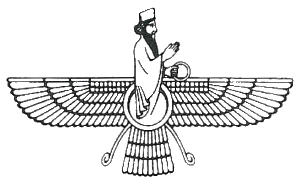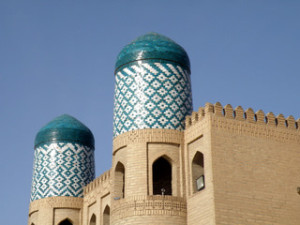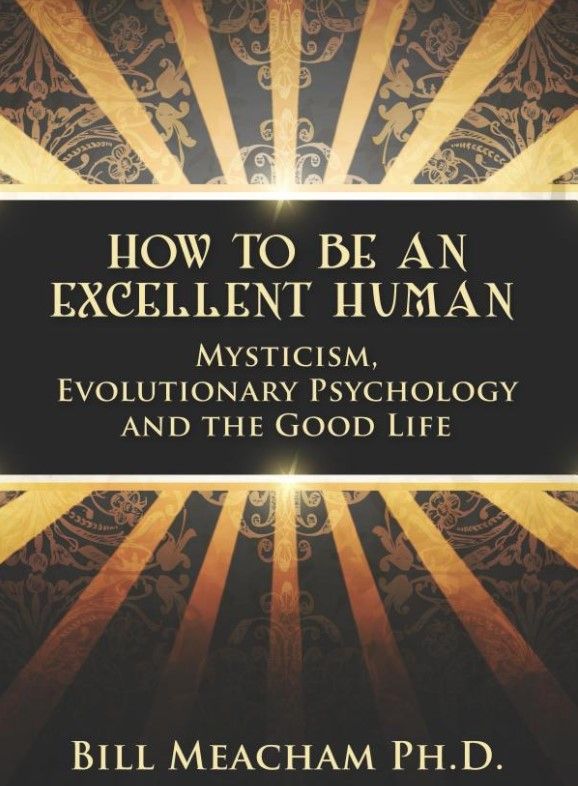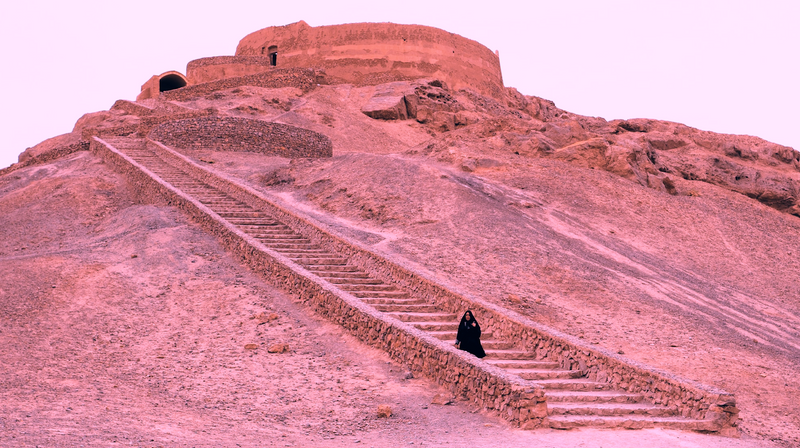Learning from Zarathustra
The universe, as they say, gave me an opportunity recently to read a couple of books on Zarathustra and Zoroastrianism. (Why we seem to want to personalize such events and attribute agency to them is a topic for another time.) A few years ago I had traveled to Uzbekistan and seen for myself the land in which Zoroastrianism first arose, so I jumped at the opportunity to learn more. This essay is a summary and interpretation of what I found out. Don’t take it as an authoritative account of Zarathustra’s teachings; it’s just an account of some things that seemed noteworthy to me.

Nobody knows for sure quite where Zarathustra lived or quite when he taught, but his origin may well have been in the Khorezm region of what is now Uzbekistan, near the western end of the great Eurasian steppe.(1) The region is dry and dusty. The once mighty Amu Darya river, known to the Greeks as the Oxus, is just a brown trickle. In Zarathustra’s time the region was no doubt wetter and more fertile, as the massive Soviet diversions of water for irrigation were far in the future.(2) Zarathustra’s culture was nomadic and pastoral, and his circumstances seem to have been modest. In one of his hymns, he prays that God will reward him with a mere ten mares, a stallion and a camel.(3)
Zarathustra is appropriately called the First Prophet. He spoke of themes later to be found in Judaism, Christianity and Islam: a single universal God, the battle between good and evil, the devil, heaven and hell, and an eventual end to the world. He addressed a people who venerated fire and worshipped the ancestral deities of the Indo-Europeans, a host of gods, demons and spirits. In contrast, he proclaimed some radical ideas:(4)
- There is only one God, not a host of them. God is named Ahura Mazda, roughly “Lord Who Is Wise,” and is a god of goodness.
- All the other gods and deities that people worship are merely attributes, partial glimpses, of Ahura Mazda. Evil deities such as the spirits of war, destruction and greed are reflections of humanity’s baser tendencies. None of them are to be worshipped.
- The source of goodness in the world is Asha, often rendered as “truth”, “reality” or “righteousness.”
- The source of evil in the world is the Lie (Druj), untruth or deception. Later personified as a supernatural being, Angra Mainyu, the concept seems at first to have been of an abstract principle. Angra Mainyu means a mind or mentality (mainyu) that is destructive or malign (angra).(5)
- Each individual has a free choice between good and evil. Following the path of goodness leads to happiness in this life, and following the path of the Lie leads to destruction. In addition, there will be a happy existence after death for those who follow goodness and an unhappy existence for those who do not.
Zarathustra denounced the practice of animal sacrifice as cruel, opposed the ritual use of the plant haoma (the soma of the Rig Veda in India), and did not preach the adoration of fire. In other words, he rejected the religion and rituals of his time, and he thereby earned the scorn and hostility of his priests and his ruling princes and warriors. He was denounced, expelled from his community, cut off from his family and clan and forced into exile. He traveled to Balkh, in today’s Afghanistan, where he found a warmer reception and became the court priest, living out his days in peace.(6)
After Zarathustra’s death, elements of the old religion came creeping back. Deities became more prominent and the use of haoma was reinstated, as was the ancient cult of fire, a tradition that continues to this day. By the sixth century B.C. the religion of Ahura Mazda had become the official state religion of Persia. Interrupted by the defeat of Persia by Alexander of Macedonia (one hesitates to call “Great” such a ruthless megalomaniac), the religion had a resurgence after Alexander’s empire broke apart, but became more and more ossified and rigid, with a proliferation of rules, a complicated set of purity laws and severe persecution of those who failed to obey.(7) After the Arabs took over in the seventh century and Islam became the official religion, the religion of Zarathustra gradually waned, living on today in communities of Parsees (Persians) in India and in scattered places throughout the rest of the world.
So why study it, if it is so obscure? Because some of its foundational concepts are still of great relevance.

Consider Asha, variously translated as “reality” and “truth.”(8) According to Dr. Jenny Rose, a professor at Claremont Graduate University, “Asha can be translated as ‘order’ or ‘arranged in cosmic cohesion,’ and thus ‘right’ in the sense of ‘as it should be.'”(9) The ancients blurred the distinction between reality, truthful statements about what reality is, and normative statements about what reality ought to be, but the point is that according to this conception there is an order or cohesion to what is real. If we could discern that order and live in harmony with it, our lives would be good, that is, fulfilled and happy.
And we can indeed discern that order, because it is seen in the biological systems that surround us and in which we live. Zarathustra recognized and valued the ordered systems of nature, which promote growth and well-being. He says, “He who cherishes Thy Way with the Good Mind is himself a promoter of abundance and prosperity.”(10) Professor Rose comments,
The good thoughts, words and actions of the ashavan [one who adheres to Asha] lead to blessings, increase, peace, wholeness and continuity of life for the individual, the community, and the land. In pursuing this course, the ashavan is emulating the increase-producing activity of Ahura Mazda, who brings benefits to the highest degree, expressed in the epithet spento.toma, ‘most beneficial’.(11)
The language here is all in what I call the Goodness Paradigm, which evaluates courses of actions in terms of observable benefits and harms rather than adherence to moral rules.(12) Zarathustra embraced what we now call Permaculture: the observation and mimicry of natural systems to create abundance.(13) The ethically good choice, the choice that promotes human flourishing, is to live in harmony with how nature works. Care for the elements – later Zoroastrianism had rules for civic hygiene and against pollution of the waters – prefigures our modern concern with healthy ecology.(14)
The opposite, interestingly, is not disharmony but the Lie (Druj), a deception or misrepresentation of reality that renders one incapable of making good choices. Unlike the Vedic morality of India in which the opposite of order is merely its absence, and unlike the Classical Greek belief that it is just ignorance that causes us to make bad choices, the evil portrayed in the earliest Zoroastrian scriptures is a forceful expression of ill will. The dregvant (one who adheres to Druj) actively chooses evil thoughts, words and actions, perpetuating cruelty, violence, ill treatment and acts of wrath and oppression.(15) Lots of things cause harm – natural disasters, wild animals, disease and so forth – but what is truly evil is the deliberate human intention to cause harm. The Lie destroys trust and tears apart the fabric of community. What’s worse, the liar becomes incapable of perceiving and acting on what is truly good, good for him (or her) as well as everyone else.
Again, the basis of ethics is the observed consequences of one’s actions. The Zoroastrian religion soon enough became full of laws and prohibitions, but the earliest insights are just common sense, couched in the desire of Ahura Mazda for human welfare. Good thoughts, good words and good deeds (humata, hukhta and hvareshta) are what is good for human beings.(16) And, by the way, notice that it starts with good thoughts. “As you think, so shall you become” is nothing new.(17)

The cosmology of Zoroastrianism is a standard dualist view of good versus evil. In the earliest writings, Ahura Mazda, the Wise Lord, is the source and creator of everything. Angra Mainyu, destructive mentality, is something like a deficiency or perversity that causes the good mentality, Spenta Mainyu, to be deceived. Later, Angra Mainyu is raised to the status of an independent being who is opposed to the Wise Lord; in other words, Satan as opposed to God. There are various theological interpretations of these two beings, disputes about which have unfortunately been the cause of wars and persecutions. Is the Devil an independent being, co-equal with God? Is God the supreme creator and the Devil one of the creatures, albeit a particularly powerful one? In either case, the world we live in is seen as a battleground in which one must choose sides.
But there is another conception, rooted in an ancient mysticism of the steppe: that both Good and Evil, God and the Devil, have their source in unity. According to researcher Tohir Karim of the Tashkent University in Uzbekistan, it is Time (Zrvana) that is the underlying or originating force that makes possible both good and evil. To be clear, this concept does not appear in the Zoroastrian scriptures; Karim cites instead the legends and traditions of Khorezm.(18) He says
At the basis of all … is the image of time, the powerful force which organizes the system of objects and events in the material world, provides for the sequence of events, and sets the whole universe in motion. Even the gods are believed to be powerless before time, as the gods, too, are seen as only a product of time as it proceeds. … [Time] was considered to exist before the material world, outside of nature, and to set nature in motion …. Zrvana (Time) in the course of its progress initially created two spirits. They were not the creators of the universe, but the results of the efforts of the powerful Zrvana.(19)
There are two ideas of note here: that all is change, and that all is one.
Time, the ongoing succession of events, is what makes everything possible. Everything changes from moment to moment. This notion of constant change echoes Heraclitus and prefigures the modern process philosophy of Alfred North Whitehead. What is ultimately real is not substance, but process. We, the living, are not anomalies in a fundamentally dead universe. We are elaborations of a life that extends down to the tiniest elements.
That Time generates all things also echoes the many strains of mysticism that assert a unity that underlies the plurality of manifestation that we live in every day: the Way of Taoism, the Brahman of Hinduism, the Original Mind of Buddhism, Ralph Waldo Emerson’s Oversoul, the Ein Sof of Jewish Kabbalah, the Godhood of the Christian mystic Meister Eckhart, the Gnostic All, the One Being of Sufism.
It is beyond the scope of this essay to explain mystical unity. Please refer to Chapters 11 through 13 of my book. I just want to examine one aspect of it. Typically the mystics say that both good and evil are aspects or manifestations of the One, and that the purpose of being human is to realize our unity with that One. It is a mistake, they say, to get caught up in dualistic struggle as if one side or the other were ultimately real. But if that is the case, why should we favor goodness over evil? If neither are the ultimate reality, why prefer one over the other?
Zarathustra suggests an answer: Because aligning yourself with the good gives you a better chance of experiencing oneness than not. You have to be alive to realize your mystical unity with the All, and it is the good that promotes life, not evil. Evil is ultimately self-destructive. (Of course I am extending Zoroastrian teachings here, which were religious and ethical, not mystical.)
What is good is analogous to light; and what is bad, or harmful, is analogous to darkness. If you live in darkness, you can’t see very well; your strategies are limited because of lack of information. They may be brutally effective for a while, but are ultimately self-defeating. It is more efficacious in the long run to live in the light, and it is much more pleasant as well. Light and dark endlessly alternate, it is true, and the alternation is all part of the whole. If you live in that knowledge, then you are enlightened. If you don’t, then turning toward the light will make it more likely that you will come to that realization.
If mysticism does not appeal to you, however, or even if you find the religious world view itself, mystical or not, distasteful or merely unlikely, the Zoroastrian ethic still makes abundant sense. Zarathustra espouses what I call the Goodness Ethic, which tells us how to live a happy, harmonious life: cultivate good thoughts, good words, and good actions.
—
Notes
(1) Karim, pp. 201-204.
(2) Wikipedia, “Amu Darya.”
(3) Kriwaczek, p. 212. The Gathas: The Hymns of Zarathushtra, 44:18.
(4) Kriwaczek, p. 213.
(5) Wikipedia, “Angra Mainyu.”
(6) Kriwaczek, pp. 213-214.
(7) Ibid., pp. 217-219.
(8) Wikipedia, “Asha.”
(9) Rose, p. 9.
(10) The Gathas: The Hymns of Zarathushtra, 49:5.
(11) Rose., p. 17.
(12) Meacham, “The Good and the Right.”
(13) Michael, “What Is Permaculture?”
(14) Rose, p. 18.
(15) Idem.
(16) Ibid., p. 17.
(17) Bruce Lee. https://www.goodreads.com/quotes/381647-as-you-think-so-shall-you-become as of 22 November 2013.
(18) Karim, p. 185-186.
(19) Ibid., pp. 210-211.
References
Karim, Tohir. Traces of the Sacred Avesta. Tashkent: Gafur Guliam, 2007.
Kriwaczek, Paul. In Search of Zarathustra: The First Prophet and the Ideas That Changed the World. New York: Alfred A. Knopf, 2003.
Meacham, Bill. “The Good and the Right.” Online publication http://www.bmeacham.com/whatswhat/GoodAndRight.html.
Meacham, Bill. How To Be An Excellent Human. Austin: Earth Harmony, 2013. Available at http://bmeacham.com.
Michael, Patricia. “What Is Permaculture?” Online publication http://patriciamichaeldesign.com/WhatIsPermaculture.htm as of 22 November 2013.
Rose, Jenny. Zorastrianism, An Introduction. London. and New York: I.B. Taurus, 2011.
The Gathas: The Hymns of Zarathushtra. Tr. D.J. Irani. Online publication http://www.zarathushtra.com/z/gatha/dji/The%20Gathas%20-%20DJI.pdf as of 20 November 2013.
Wikipedia. “Amu Darya.” Online publication http://en.wikipedia.org/wiki/Amu_Darya as of 20 November 2013.
Wikipedia. “Angra Mainyu.” Online publication http://en.wikipedia.org/wiki/Angra_Mainyu as of 20 November 2013.
Wikipedia. “Asha.” Online publication http://en.wikipedia.org/wiki/Asha as of 21 November 2013.

How To Be An Excellent Human
Mysticism, Evolutionary Psychology and the Good Life by Bill Beacham, Ph.D.

